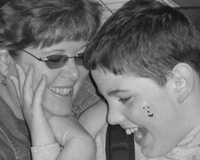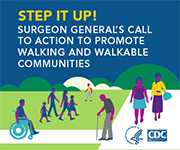Safe Transport in Emergencies
 Read one family’s story to find out how emergency preparedness can affect children with special health care needs.
Read one family’s story to find out how emergency preparedness can affect children with special health care needs.
Children with disabilities sometimes have added challenges during an emergency situation compared to children without disabilities. For instance, children with disabilities may have a hard time moving from one location to another, have difficulty communicating, or have trouble adjusting to different situations. Being without transportation can present major challenges during a natural disaster. If someone in your family has a special health care need, it is important to have a plan in place that includes reliable transportation and a backup plan, in case your vehicle becomes damaged during a storm.
Sam’s Story
 A severe ice storm hit the Midwest, leaving Mary and her family without power, heat, or a reliable car. Mary’s son, Sam, has spastic quadriplegia cerebral palsy. Cerebral palsy is a group of disorders that can affect a person’s ability to move and maintain balance and posture. Sam requires a specialized wheelchair and a wheelchair-accessible van in order to move from place to place. But during the ice storm, Mary’s van was damaged, keeping her from taking her son to a place where he could receive proper medical attention in a safe environment.
A severe ice storm hit the Midwest, leaving Mary and her family without power, heat, or a reliable car. Mary’s son, Sam, has spastic quadriplegia cerebral palsy. Cerebral palsy is a group of disorders that can affect a person’s ability to move and maintain balance and posture. Sam requires a specialized wheelchair and a wheelchair-accessible van in order to move from place to place. But during the ice storm, Mary’s van was damaged, keeping her from taking her son to a place where he could receive proper medical attention in a safe environment.
Mary quickly turned to her local community for help. “I called the sheriff’s office on that day, and was told to take him to the hospital,” she says. She soon realized that there was not an emergency plan in place to provide transportation for people in wheelchairs to help them get to shelters or the hospital. Without transportation, Mary and Sam were left stranded in their home. Mary encourages families with a child with a special health care need who could face similar emergencies to have an escape plan in place. “Have a set plan for transportation and a place that is safe and able to take care of your child.”
You can work with your community organizations ahead of time to find out if evacuation plans are available or not. If not, you can create your own plan for evacuating your family during an emergency.
CDC would like to thank Mary and Family Voices for sharing this personal story.
About Cerebral Palsy
Cerebral palsy (CP) is a group of disorders that affect a person’s ability to move and maintain balance and posture. Cerebral means having to do with the brain. Palsy means weakness or problems with using the muscles. CP is the most common motor disability in childhood. Motor disabilities are problems doing certain tasks that depend upon muscles to work adequately, such as walking, running, skipping, tying shoes, crawling, sitting, handwriting, and others. CP is caused by abnormal brain development or damage to the developing brain that affects a person’s ability to control his or her muscles.
How Can I Prepare for an Emergency?
The possibility of public health emergencies arising in the United States concerns many people in the wake of recent hurricanes, tsunamis, acts of terrorism, and the threat of pandemic influenza. Though some people feel it is impossible to be prepared for unexpected events, the truth is that taking preparedness actions helps people deal with disasters of all sorts much more effectively when they do occur. Remember these three easy steps to help your family prepare for an emergency.
For more information and resources to help you prepare, contact any of the following:
- Your local American Red Cross chapter
- Your state and local health departments
- Your local emergency management agency
- CDC Public Response Hotline
English 1-888-246-2675
Spanish 1-888-246-2857
TTY 1-866-874-2646)
How Can I Arrange for Safe Transportation in an Emergency?
Individual assistance may be available in your community. Register in advance with the office of emergency services, the local fire department, other government agencies or non-profit groups. Tell them of your individual needs or those of a family member and find out what assistance, help or services can be provided.
Work with local transportation and disability services (e.g., Paratransit, Independent Living Centers) to plan ahead for accessible transportation if you may need that for evacuation or other reasons during a disaster.
More Information
- Page last reviewed: November 16, 2016
- Page last updated: November 16, 2016
- Content source:
- National Center on Birth Defects and Developmental Disabilities
- Page maintained by: Office of the Associate Director for Communication, Digital Media Branch, Division of Public Affairs




 ShareCompartir
ShareCompartir